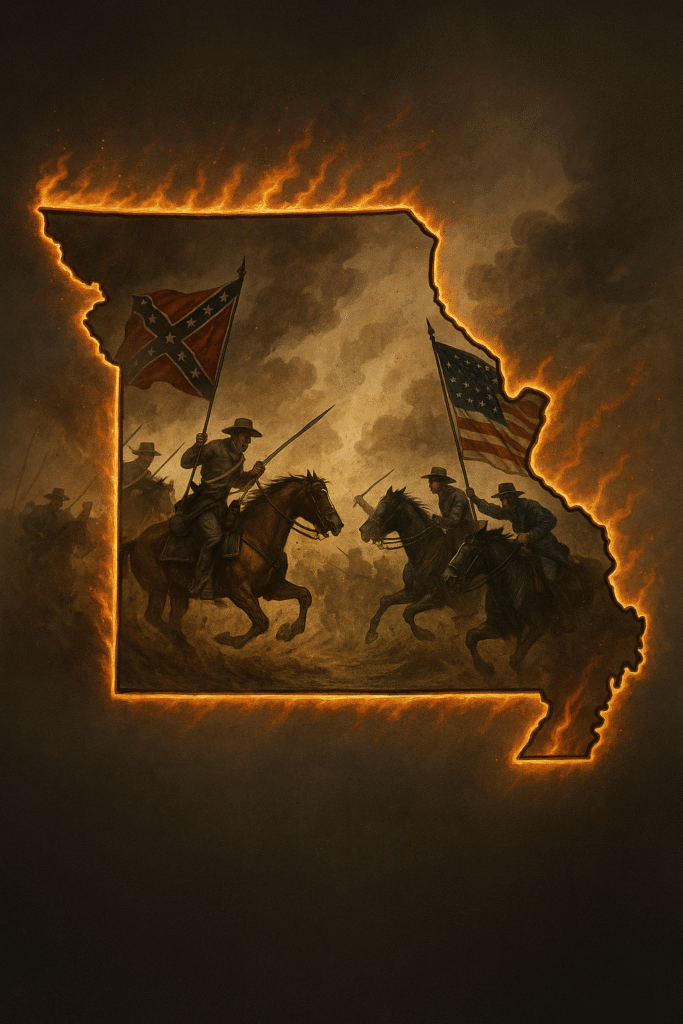In 1863, General Order No. 11 emptied four Missouri counties, fueling the “Burnt District.” Why it was issued, what it did, and how it reshaped the border war.
Table of Contents
General Order No. 11
Missouri’s guerrilla war hit a breaking point in late summer 1863. After years of raids and reprisals along the Kansas–Missouri line, violence spiked: a Kansas City jail collapsed on young female prisoners tied to bushwhackers, and days later William Quantrill’s men massacred civilians at Lawrence, Kansas. Union commander Brig. Gen. Thomas Ewing Jr. answered with one of the most drastic actions of the war—General Order No. 11.
Why the Order Was Issued
- Escalating guerrilla violence: Ambushes, assassinations, and supply-line attacks plagued western Missouri.
- Jail collapse (Aug 13, 1863): A makeshift women’s prison in Kansas City failed, killing and injuring relatives of prominent guerrillas—outrage that further inflamed the border.
- Lawrence Massacre (Aug 21, 1863): Quantrill’s raid killed around 150–200 men and boys. Ewing, commanding the District of the Border, moved to sever guerrillas from local support.
What General Order No. 11 Did
Issued Aug 25, 1863, the order targeted the rural parts of Jackson, Cass, and Bates Counties, and northern Vernon County in Missouri:
- Mandatory evacuation: Most rural residents had 15 days to leave.
- Where people could go:
- Those who could prove loyalty could move into a few garrisoned towns (e.g., Kansas City, Independence, Westport, Harrisonville) or settle near designated military posts.
- Those unable or unwilling to prove loyalty had to leave the district entirely.
- Property & provisions: Movable goods (grain, livestock) were often seized, sold, or destroyed to deny guerrillas supplies.
- Enforcement: Federal troops and Kansas militia enforced the order. Irregulars and opportunists added to the devastation
The “Burnt District”
As families abandoned farms, patrols torched empty homes and outbuildings to keep them from sheltering bushwhackers. What followed gave the region its enduring name—the “Burnt District.”
- Fields untended, towns thinned: Entire neighborhoods vanished; fences fell; roads went quiet.
- Women, children, the elderly: The burden fell heaviest on those left behind when men were away—or dead.
- Black Missourians: Enslaved and free Black families navigated evacuation amid danger and opportunity, sometimes seeking protection near Union posts.
Did It Work?
Short term, the order disrupted guerrilla logistics. Fewer safe houses and food caches made sustained operations harder. But it also deepened bitterness and a sense of collective punishment, feeding the war’s long memory.
The Backlash—on Canvas and in Politics
Artist and Unionist George Caleb Bingham condemned Ewing’s policy in his famous painting “Order No. 11,” portraying the removal as arbitrary and cruel. The image shaped public memory, especially in Missouri, where civilians saw the order as punishment for the crimes of a few.
Legacy
General Order No. 11 stands as one of the most controversial home-front actions of the Civil War. It captured the impossible math of Missouri’s conflict: stop the raids, and you risk scorched-earth policies; spare the countryside, and guerrillas thrive. The order ended many raids—but it scarred communities for generations.
Go Explore
- Jackson, Cass, Bates, Vernon Counties: Interpretive markers and local museums recount the Burnt District story.
- Kansas City & Independence sites: Learn how garrison towns functioned and why people clustered there.
- Regional archives: Letters and county histories preserve voices of families caught in the evacuation.
Plan Your Next Missouri Civil War Adventure!
Ready to hit the road?
Plan your Missouri Civil War adventure with trusted travel tips, tools, and resources. Visit our Resource Page (Missouri Civil War Resources) to find everything you need for hotels, flights, car rentals, gear, and more.
Check Out These Other Civil War Articles
Missouri Civil War: Why This Forgotten Story Matters
Civil War In Missouri: 6 Questions You Should Ask
Bleeding Kansas: Missouri’s Volatile Border War (1854–61)
Missouri – 3 Reasons It Was the Civil War’s Western Key
General Lyon Takes Missouri: 1861’s Breaking Point
Guerrilla Warfare in Missouri: Chaos Explodes (1861–65)
The Cloak and Dagger Side of Missouri’s Civil War
Missouri Women at War: Discover The Unsung Heroes
Check Out These Books Published By The Sojourner’s Compass
“Battles & Beyond” – Companion Book Series
From river crossings to ridge fights, Missouri’s Civil War story was one of chaos, courage, and contested loyalties. This travel-ready series delivers concise battlefield guides packed with historical context, walking tips, firsthand quotes, and itinerary tie-ins—perfect for travelers, educators, and armchair historians alike.
Led by Jonathon Midgley, author of The Last Hand series, each volume brings forgotten fights into clear focus—making it easy to explore the war’s impact, one battlefield at a time.
Available On Amazon & Kindle Unlimited
How to Plan a Budget-Friendly Getaway in Missouri: Smart Travel Strategies for Affordable Adventures
Explore Missouri with confidence, strategy, and style—without breaking the bank. This guide delivers smart travel tools, scenic itineraries, and insider tips on lodging, dining, and hidden gems across the state.
Whether you’re road-tripping solo or planning a family escape, this eBook is your map to affordable adventure and stress-free travel.
Available On Amazon & Kindle Unlimited
Stay Connected
Follow us for travel inspiration, new articles, and short-form video features:
The Sojourner’s Compass TikTok
The Sojourner’s Compass YouTube
The Sojourner’s Compass Facebook
The Sojourner’s Compass Main Website


Leave a Reply